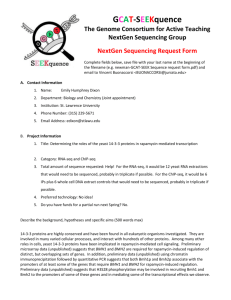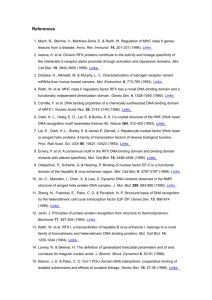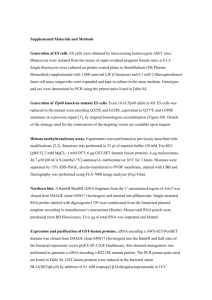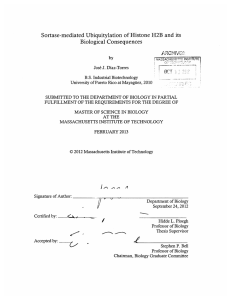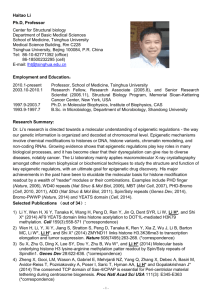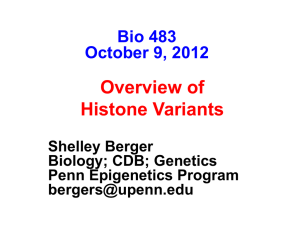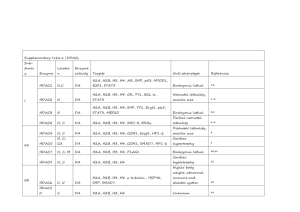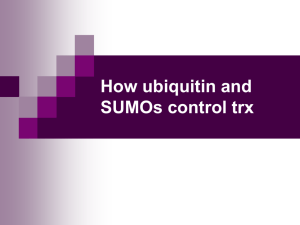NIH CA118357-05 - UNM Cancer Center
advertisement
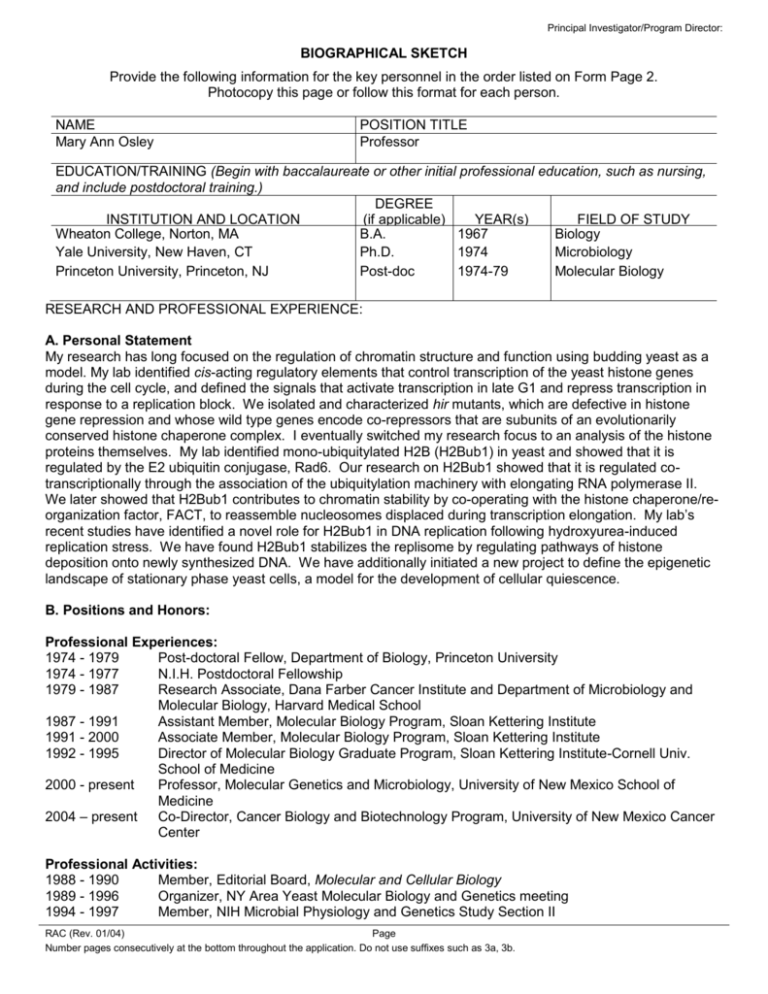
Principal Investigator/Program Director: BIOGRAPHICAL SKETCH Provide the following information for the key personnel in the order listed on Form Page 2. Photocopy this page or follow this format for each person. NAME Mary Ann Osley POSITION TITLE Professor EDUCATION/TRAINING (Begin with baccalaureate or other initial professional education, such as nursing, and include postdoctoral training.) DEGREE INSTITUTION AND LOCATION (if applicable) YEAR(s) FIELD OF STUDY Wheaton College, Norton, MA B.A. 1967 Biology Yale University, New Haven, CT Ph.D. 1974 Microbiology Princeton University, Princeton, NJ Post-doc 1974-79 Molecular Biology RESEARCH AND PROFESSIONAL EXPERIENCE: A. Personal Statement My research has long focused on the regulation of chromatin structure and function using budding yeast as a model. My lab identified cis-acting regulatory elements that control transcription of the yeast histone genes during the cell cycle, and defined the signals that activate transcription in late G1 and repress transcription in response to a replication block. We isolated and characterized hir mutants, which are defective in histone gene repression and whose wild type genes encode co-repressors that are subunits of an evolutionarily conserved histone chaperone complex. I eventually switched my research focus to an analysis of the histone proteins themselves. My lab identified mono-ubiquitylated H2B (H2Bub1) in yeast and showed that it is regulated by the E2 ubiquitin conjugase, Rad6. Our research on H2Bub1 showed that it is regulated cotranscriptionally through the association of the ubiquitylation machinery with elongating RNA polymerase II. We later showed that H2Bub1 contributes to chromatin stability by co-operating with the histone chaperone/reorganization factor, FACT, to reassemble nucleosomes displaced during transcription elongation. My lab’s recent studies have identified a novel role for H2Bub1 in DNA replication following hydroxyurea-induced replication stress. We have found H2Bub1 stabilizes the replisome by regulating pathways of histone deposition onto newly synthesized DNA. We have additionally initiated a new project to define the epigenetic landscape of stationary phase yeast cells, a model for the development of cellular quiescence. B. Positions and Honors: Professional Experiences: 1974 - 1979 Post-doctoral Fellow, Department of Biology, Princeton University 1974 - 1977 N.I.H. Postdoctoral Fellowship 1979 - 1987 Research Associate, Dana Farber Cancer Institute and Department of Microbiology and Molecular Biology, Harvard Medical School 1987 - 1991 Assistant Member, Molecular Biology Program, Sloan Kettering Institute 1991 - 2000 Associate Member, Molecular Biology Program, Sloan Kettering Institute 1992 - 1995 Director of Molecular Biology Graduate Program, Sloan Kettering Institute-Cornell Univ. School of Medicine 2000 - present Professor, Molecular Genetics and Microbiology, University of New Mexico School of Medicine 2004 – present Co-Director, Cancer Biology and Biotechnology Program, University of New Mexico Cancer Center Professional Activities: 1988 - 1990 Member, Editorial Board, Molecular and Cellular Biology 1989 - 1996 Organizer, NY Area Yeast Molecular Biology and Genetics meeting 1994 - 1997 Member, NIH Microbial Physiology and Genetics Study Section II RAC (Rev. 01/04) Page Number pages consecutively at the bottom throughout the application. Do not use suffixes such as 3a, 3b. Principal Investigator/Program Director: 2000 - 2004 2005, 2006 2004 – present 2006 – present 2009 - present 2007- 2011 1988 – Present Member, NCI Special Manpower Training Study Section, Subcommittee F Ad-hoc Member, NCI Special Manpower Training Study Section, Subcommittee F Ad-hoc Member, NSF Biochemistry of Gene Expression review panel Member, Editorial Board, Molecular and Cellular Biology Member, Editorial Board, BBA Gene Regulatory Mechanisms Member, NIH MGC Study Section Reviewer: Cell, Mol. Cell, Science, Nature, Nature Struct. & Mol. Biol., Nature Cell Biol., Genes Dev., Curr. Biol., Mol. Cell. Biol., Genetics, Proc. Natl. Acad. Sci. USA, EMBO J., Nuc. Acids Res., Eukaryotic Cell, BBA Gene Reg Mech, PLoS Journals, J Cell Biol C. Relevant Peer-Reviewed Publications: 1. Dimova D, Nackerdien Z, Furgeson S, Eguchi S and Osley MA: Role for transcriptional repressors in targeting the yeast Swi/Snf complex. Mol. Cell, 4: 75-83, 1999. 2. Robzyk K, Recht J and Osley MA: Rad6-dependent ubiquitination of histone H2B in yeast. Science, 287: 501-504, 2000. 3. Sutton A, Bucaria J, Osley MA and Sternglanz R: Yeast ASF1 protein is required for cell cycle regulation of histone gene transcription. Genetics, 158: 587-596, 2001. 4. Martini EM, Keeney S and Osley MA: A role for histone H2B during repair of UV-induced DNA damage in Saccharomyces cerevisiae. Genetics, 160: 1375-1387, 2002. 5. Sharp JA, Franco A, Osley MA and Kaufman PD: Chromatin Assembly Factor-I and Hir proteins contribute to building kinetochores in Saccharomyces cerevisiae. Genes Dev., 16: 85-100, 2002. 6. Henry, K., Wyce, A., Lo, W.-S., Duggan, L., Emre, T., Kao, C.F., Pillus, L., Shilatifard, A., Osley, MA, and Berger, SL: Transcriptional activation via sequential histone H2B ubiquitylation and deubiquitylation, mediated by SAGA-associated Ubp8. Genes Dev 17: 2648-2663, 2003. 7. Kao, C.F., Hillyer, C., Tsukuda, T., Henry, K., Berger, S., and Osley, MA: Rad6 plays a role in transcriptional activation through ubiquitylation of H2B. Genes Dev. 18: 184-195, 2004 8. Xiao, X, Kao, CK, Krogan, N, Greenblatt, J, Sun, ZW, Osley, MA, and Strahl, B: Rad6-dependent ubiquitylation of H2B is associated with elongating RNA polymerase II. Mol. Cell. Biol. 25: 637-651, 2005. 9. Tsukuda, T, Fleming, A, Nickoloff, J.A, and Osley, MA: Chromatin remodeling at a DNA double-strand break site in Saccharomyces cerevisiae. Nature 438: 379-383, 2005. 10. Fleming, AB, Kao, C-F, Hillyer, C, Pikaart, M, and Osley, MA: H2B ubiquitylation plays a role in nucleosome dynamics during transcription elongation. Mol Cell 31: 57-66, 2008. 11. Tsukuda, T, Lo, Y-C, Krishna, S, Sterk, R, Osley, MA, and Nickoloff, J: INO80-dependent chromatin remodeling regulates early and late stages of mitotic homologous recombination. DNA Repair 8: 360-360, 2009. 12. Nakanishi, S, Lee, JS, Gardner, JM, Takahashi, Y, Chandrasekharan, Sun, ZW, Osley, MA, Strahl, B, Jasperson, SL, Shilatifard, A: Histone H2BK123 monoubiquitination is the critical determinant for H3K4 and H3K79 trimethylation by COMPASS and Dot1. J Cell Biol 186: 371-377, 2009. 13. Amin, A, Dimova, D, Ferreira, M, Vishnoi, M, Hancock, L, Osley, MA*, and Prochasson, P*. The mitotic Clb cyclins are required to alleviate HIR-mediated repression of the yeast histone genes at the G1/S transition. BBAGRM. 1819: 16-27, 2012. 14. Shieh, GS, Pan, C-H, Wu J-H, Sun, Y-J, Chang, K-W, Tung, L, Chang, T-H, Fleming, A, Hillyer, C, Berger, SL, Osley, MA* and Kao, C-K*: H2B ubiquitylation is part of chromatin architecture that marks exon-intron structure in budding yeast. BMC Genomics 12: 627, 2011. 15. Trujillo, KM and Osley, MA: A role for H2B ubiquitylation in DNA replication, Mol Cell, 48: 734-746, 2012. RAC (Rev. 01/04) Page Number pages consecutively at the bottom throughout the application. Do not use suffixes such as 3a, 3b. Principal Investigator/Program Director: D. Research Support: Active: NIH GM40118-22 Title: “ “Genetic Analysis of H2B Ubiquitylation”. PI: Mary Ann Osley Period: 08-01-12 through 07/31/16 Direct costs: $239,000 per year This grant supports research to examine the role of H2B ubiquitylation in transcription, replication, and chromatin stability, and to define the epigenetic landscape of quiescent yeast cells. Pending: NIH AG044354-01 Title: “Contributions of epigenetics to cellular quiescence and chronological aging” PI: Mary Ann Osley Period: 12/01/12 through 11/31/17 Direct costs: $250,000 per year This grant will support studies to define the role of histone modifications in the development and survival of quiescent cells formed during chronological aging. Completed: NIH CA118357-05 Title: “Chromatin Regulation of Double-Strand Break Repair” PI: Mary Ann Osley Period: 02/01/06 through 01/31/11 Direct costs: $172,500 per year This grant supported research on the role of chromatin remodeling in the repair of DNA double-strand breaks. NSF MCB-9986650 Title: “Roles of Histone Ubiquitination in Yeast” PI: Mary Ann Osley Period: Feb. 1, 2000-March 31, 2001 Total costs: $100,346 This grant supported a pilot study to characterize the factors regulating H2B ubiquitylation in yeast. This research was subsequently folded into NIH GM40118. HFSPRG254/97 Title: “HIR Proteins in Chromatin Assembly, Transcriptional Regulation, and Development” PI: Marc Lipinski (France) Period: Oct. 1, 1997-February 28, 2001 Total costs: $720,000; $126,000 total Osley share This was a collaborative, international grant from the Human Frontiers of Science Program to support research on the evolutionarily conserved HIR proteins that my laboratory originally identified in yeast. RAC (Rev. 01/04) Page Number pages consecutively at the bottom throughout the application. Do not use suffixes such as 3a, 3b.
